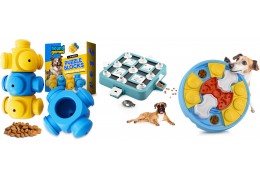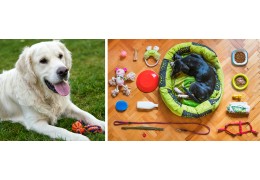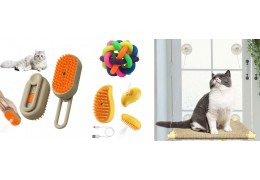Choosing the right small pet carrier is essential for your pet’s safety and comfort during travel. This guide...
The Importance of Nail Trimming for Dogs and How to Do It Safely
Keeping your dog's nails trimmed is a crucial part of pet care that many owners overlook. Long nails can cause discomfort, lead to posture problems, and even increase the risk of injury. Regular trimming using high-quality dog toenail trimmers, along with other essential dog grooming tools, ensures your pet's paws remain healthy and pain-free. Choosing the right dog nail trimmer and learning safe trimming techniques can make the process stress-free for both you and your dog.
This guide covers why nail trimming is important, how often to do it, and step-by-step instructions to ensure a smooth and safe experience.
Why Nail Trimming Is Essential for Your Dog's Health
Many pet owners assume that their dog's nails will naturally wear down through outdoor activities. However, most dogs—especially those living indoors or walking on soft surfaces—need regular nail trims.
The Risks of Overgrown Nails
1. Pain and Discomfort
Long nails put pressure on the nail bed, leading to pain when walking.
Dogs may start cleaning or shifting their weight awkwardly to avoid discomfort.
2. Posture and Joint Issues
Overgrown nails force dogs to change their walking posture.
This can lead to joint strain, arthritis, and long-term mobility issues.
3. Increased Risk of Injuries
Long nails can get caught in carpets, furniture, or cracks in the floor.
A torn nail can be extremely painful and may require veterinary attention.
4. Nail Splitting and Infections
If a nail breaks unevenly, it can expose the quick (the sensitive inner part of the nail), leading to bleeding and infection.
Using proper dog toenail trimmers reduces the risk of painful splits.
By maintaining a regular nail-trimming schedule with the right dog grooming tools, you can prevent these issues and keep your pet comfortable.
How Often Should You Trim Your Dog's Nails?
The frequency of nail trimming depends on your dog's lifestyle, breed, and activity level.
• Active dogs that walk on hard surfaces (concrete, pavement) may naturally wear down their nails and require trimming once a month.
• Indoor dogs or those walking on soft surfaces (grass, carpet) will need trimming every two to three weeks.
• Dewclaws (if present) often don't touch the ground and may require trimming more frequently to prevent curling.
A good rule of thumb: If you hear your dog's nails clicking on the floor, it's time for a trim!
Choosing the Right Dog Nail Trimmer
Using the correct dog nail trimmer makes the process safer and easier. There are three main types:
1. Guillotine Clippers
o Best for small to medium-sized dogs.
o Features a hole where the nail is inserted before a blade slices through.
2. Scissor-Style Clippers
o Ideal for large dogs with thick nails.
o Works like scissors, providing more control and strength.
3. Electric Nail Grinders
o A great alternative for dogs who dislike traditional clippers.
o Use a rotating grinding stone to file down the nail slowly.
If you're unsure which option to choose, investing in high-quality dog toenail trimmers that fit your dog's size and comfort level is the best approach.
Step-by-Step Guide to Trimming Your Dog's Nails Safely
1. Gather Your Supplies
Before starting, have everything ready to ensure a smooth experience:
• A sharp dog nail trimmer (clippers or grinder)
• Styptic powder or cornstarch (to stop bleeding if you cut the quick)
• A towel or blanket (for comfort and stability)
• Treats and positive reinforcement
2. Choose a Quiet, Calm Location
Dogs can be sensitive to nail trimming, so pick a quiet spot where they feel safe. Avoid loud noises or distractions.
3. Get Your Dog Comfortable
• Gently hold their seconds paw and massage it for a few to relax them.
• If your dog is nervous, let them sniff the dog grooming tools before starting.
• Use a soothing voice and offer treats throughout the process.
4. Identify the Quick
The "quick" is the pink section inside the nail that contains blood vessels and nerves. Cutting into the quick can cause bleeding and pain.
• For light-colored nails – The quick is visible as a pink area inside the nail.
• For dark-colored nails – Trim small bits at a time and look for a chalky white center, which signals you’re getting close to the quick.
5. Trim Small Sections at a Time
• Hold the paw firmly but gently.
• Position the dog toenail trimmers at a slight angle.
• Clip small portions of the nail at a time instead of cutting off a large chunk.
If your dog resists, take breaks and offer praise. Rushing can make the experience more stressful.
6. Smooth the Edges (Optional)
If using clippers, you can file or grind the edges to prevent rough, sharp tips that might scratch surfaces or skin.
7. Reward and Praise
After each paw, give your dog a treat and lots of praise. This positive reinforcement helps them associate nail trimming with rewards rather than fear.
Common Mistakes to Avoid
1. Cutting Too Close to the Quick
o If you accidentally cut the quick, apply styptic powder or cornstarch to stop bleeding.
2. Skipping Regular Trims
o The longer you wait, the harder it is to trim nails safely. Long nails push the quick further out, making trimming more difficult over time.
3. Using Dull Clippers
o Dull dog nail trimmers can crush instead of cutting, leading to pain and splintering. Always keep clippers sharp or replace them when needed.
4. Forcing the Process
o If your dog is extremely anxious, stop and try again later rather than forcing them to endure the experience.
Alternative Nail Care Options
If your dog strongly dislikes nail trimming, try these alternatives:
• Frequent Walks on Hard Surfaces – Helps naturally wear down nails.
• Paw Balm & Moisturizers – Keeps nails and paw pads healthy.
• Professional Grooming Services – If you're uncomfortable trimming at home, a groomer or vet can help.
Final Thoughts
Regular nail trimming is essential for your dog's comfort, mobility, and overall health. Using the right dog toenail trimmers, selecting the best dog grooming tools, and following a gentle, patient approach can make nail trimming a stress-free experience. Investing in a quality dog nail trimmer and maintaining a consistent trimming schedule will keep your pet’s paws in great shape and prevent painful overgrowth.
By practicing safe trimming techniques and rewarding your dog for cooperation, you’ll ensure nail care becomes an easy, routine part of your pet’s grooming schedule.












